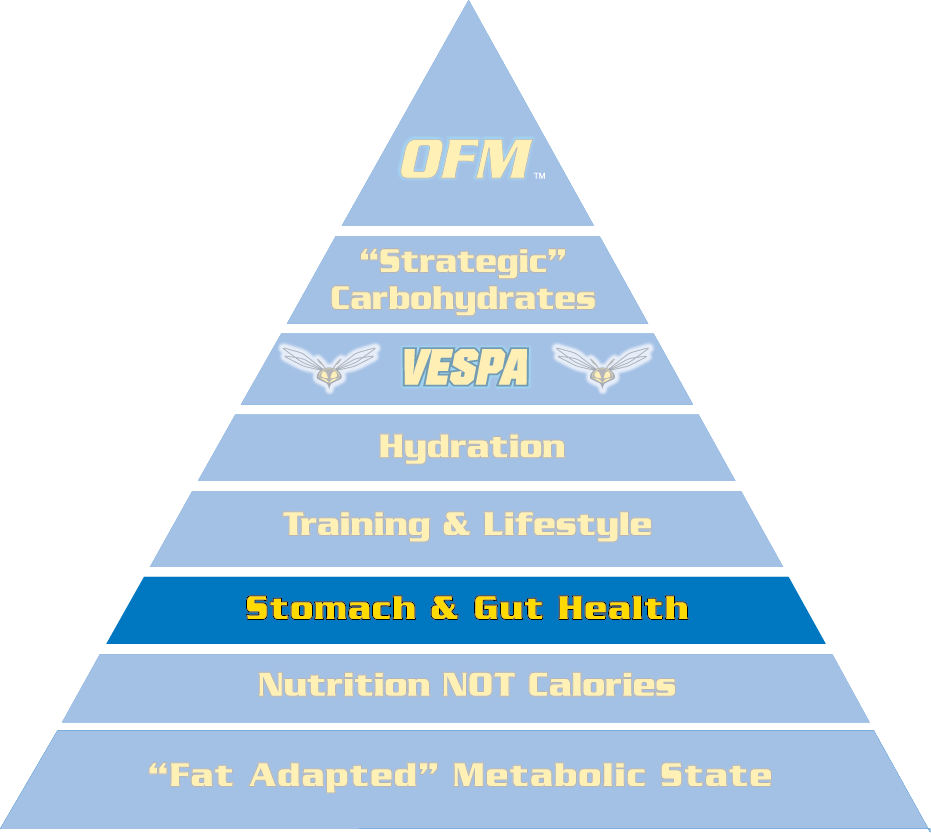
This competition can yield a “balanced” biome where potentially pathogenic flora are kept in check and a healthy symbiotic relationship with the host (you) resulting in vibrant health. When the biome is impacted and shifts, this can result with overgrowths commonly known as an infection, thus necessitating treatment with medications like antibiotics, antifungals, antivirals etc.
1) Mindset / Approach: The first thing an athlete needs to understand is the impossibility of trying to “engineer” or “bio-hack” a protocol where everything is broken down into specific components. So, an aware yet relaxed approach toward understanding what impacts the health and well-being of your unique flora will allow you to effectively master the Stomach & Gut Health Tier of the OFM Pyramid.
2) Stomach & Gut Epithelium Health: Naturally, maintaining the health and robustness of the stomach and gut epithelium is key to giving your stomach and gut flora a great environment in which to thrive. This is the foundation. Read more here (hyperlink).
3) Probiotic Strategies: There are a number of well-known strategies for bolstering your biome.
- Colonizing Probiotic Supplements.
- Whole milk live culture dairy products like Yoghurt, Kefir, Labne, Buttermilk, Cottage Cheese
- Fermented Vegetables: Sauerkrauts, Kimchi, Kombucha
- Fermented Soy: Natto, Miso
While these are all have their benefits, most of what the consumer is hearing on Probiotics and Probiotic foods etc. is greatly oversold and mis-leading. While they generally do not have a downside their influence, at best, is to help shift the biome toward a more balanced more robust flora.
Probiotic Supplements: Because of the media hype on probiotics many consumers are unaware most Probiotic supplements do not colonize so their influence is small and temporary at best. So finding a Probiotic supplement using strains that colonize along with a delivery system which will transit the stomach and small intestine to reach the colon so the strains can colonize in large enough numbers to have a meaningful benefit is key but rarely mentioned. The other key benefit of using the proper colonizing probiotic supplement is you save money because, normally, you do not need to take it daily as your biome is robust and balanced and a small but constant influx of flora from probiotic foods helps to maintain this healthy biome balance.
Probiotic strategies should be carefully and thoughtfully deployed under the following circumstances:
- After taking a course of antibiotics. In certain European countries probiotics are actually prescribed anytime a course of antibiotics are prescribed.
- During and after a course of Corticosteroids like Prednisone which are often prescribed to athletes for a variety of acute/severe inflammatory issues. This class of anti-inflammatory drugs lower your immune system so bolstering it to the extent that is possible can help mitigate the side-effects.
- Post competition for ultra-endurance athletes.
- Anytime after a prolonged period where consumption of solely canned, packaged, or preserved foods (not requiring refrigeration) is the only food option. Examples would be a long military deployment in the field with only MRE’s etc. to eat or a long backpacking trip.
- If you have a bout of diarrhea.
- Prior to, during and post travel to overseas and/or developing countries. This is a tricky one as the bacterial profile best suited to the foods and sanitary conditions one encounters during travel may differ from what you are taking. The good news is your flora are highly adaptable and given time can adapt to a different food source and exposure to other flora. Staying hydrated and minimizing the impacts of jet lag will help both you and your flora make the transiton.
Probiotic Foods: The principle benefit of Probiotic foods is not so much that your body is obtaining a large inoculation of “healthy” bacteria but more so by the bacteria breaking down proteins and carbohydrates of their food substrate and converting these foods so they are much nutritionally bio-availanble into fatty acids and digestion friendly to the relatively limited digestive capabilities of the human digestive tract (see human digestive tract basics here).
Because of this breakdown/conversion and the nutrition it provides consumption of probiotic foods is especially important for vegetarians and vegans.
The “take-home” message is making naturally fermented live culture probiotic foods part of your regular daily diet has no downside risk with several potential upside benefits but athletes need to be aware of the hype of overzealous marketing departments offering these probiotic foods. Make these foods a side dish or condiment as practiced by traditional cultures who have used these foods for centuries.
4) Common Factors which negatively impact the biome:
Strategies to bolster the biome are only half the story. In today’s modern world humans are exposed to a host of elements which can negatively impact the biome. Some are daily exposures we commonly take for granted. Awareness can mitigate or minimize their impact.
a) Avoid highly processed foods, especially those which need lots of preservatives, particularly preservatives with highly technical chemical names only an organic chemist would be able to understand.
b) Avoid constant consumption of concentrated carbohydrates as this will shift the biome to favoring pathogenic bacteria and fungus like Candida etc.
c) Minimize the use of concentrated carbs and sugars during competition due to the oxdative stress this places on your epithelium. This is an important, yet unseen, benefit to optimizing fat metabolism.
d) Many fresh vegetables like baby carrots and ready to eat salad mixes etc. should be rinsed thoroughly in water just like regular produce because these fresh “convenience foods” are often treated to kill bacteria and suppress bacterial growth.
e) If your municipal water supply is chlorinated or fluoridated switch from drinking tap water to a water supply which is neither chlorinated or fluoridated and contains low to non-detectable levels of naturally-occurring fluoride. If you are on well water have it tested for nitrates, pesticides, heavy metals etc.
f) Fluoride Toothpaste…virtually all commonly available brands! If you continue to use a fluoride toothpaste be extra vigilant to rinse thoroughly. Unfortunately it does not end there as many of the non-fluoride toothpastes contain other ingredients which also potentially impact your biome and your health. For more detailed information; https://besttoothpaste.net/
g) Avoid the over-consumption of antibiotics. Antibiotics can literally be a lifesaver, however, save them for those life-threatening and other antibiotic appropriate situations and follow up with a course of Probiotics which colonize.
h) Avoid the use of Hand Sanitizers and Anti-bacterial soaps except for critical situations such as a doctor prepping for an operation. Most of the active ingredients like Triclosan, are endocrine and/or DNA/RNA disruptors which research now is suggesting negatively impacts the human biome far more than previously thought. Regular soaps are a much safer alternative.
i) Avoid consuming foods which potentially contain glyphosate contamination (commonly known as RoundupTM ). These can include foods containing soy, corn and canola oil all which are now widely grown using glyphosate resistant seed strains. While glyphosate is not toxic to mammalian cells it “works” on plants by disrupting the Shikimate pathway which happens to also be a critical amino acid synthesis pathway for bacteria. Because these agricultural products are widely used in food processing they are likely to pop up in any number of processed foods including many products sold on their “health” benefits. Again, another reason to avoid highly processed foods.
j) Minimize the use of synthetic and/or artificial sweeteners. Emerging research is suggesting among other potential downsides to artificial sweeteners they negatively impact the biome in several ways both subtle and not so subtle. Eliminate their use when possible, substitute their use with natural sweeteners, however, being mindful natural sweeteners also have their issues; “You don’t get something for nothing!” OFM Connection: By becoming metabolically “fat-adapted” athletes’ taste buds tend to become much more sensitive to “sweetness” so the craving for sweets is significantly diminished and the amount of sweetener necessary for sports drinks, juices, desserts or sweet snacks is much, much less. Most athletes report sweet food or drinks they used to consume taste “sickeningly” sweet once they are fat-adapted.

